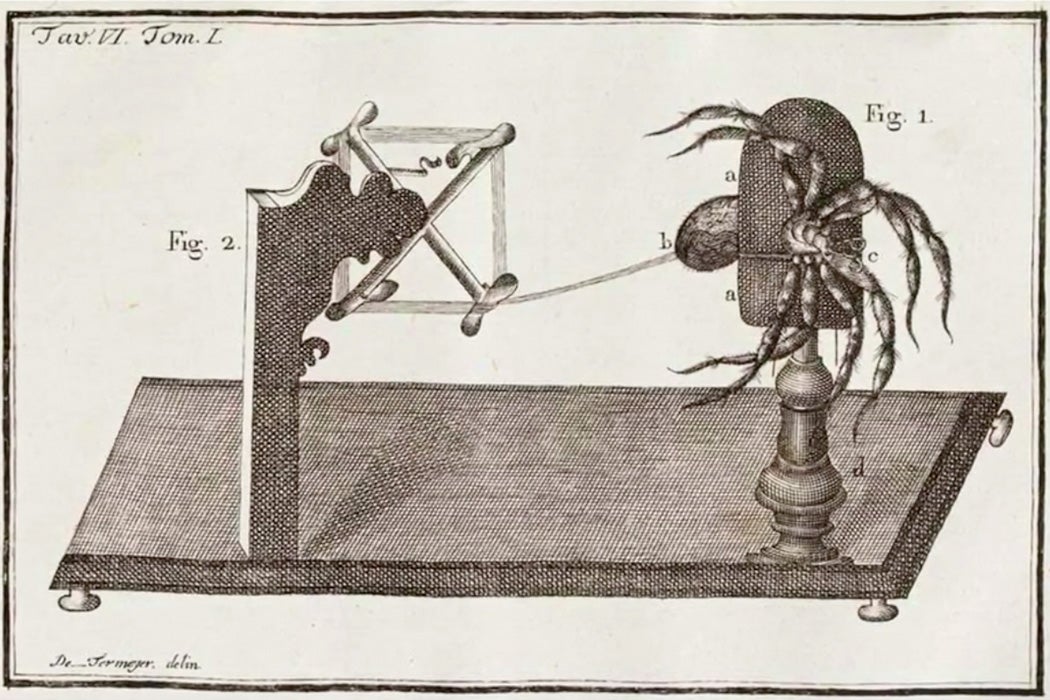A few years ago, my mother gave me a silk scarf. It is a singularly satisfying thing to touch: as light as a breeze, as smooth as water. It’s difficult to believe that the threads that make up the cloth were woven by little white worms, extracted from the fortresses they spun as they embarked on the metamorphosis from larva to moth. Silk is wonderful. But for centuries, people have been captivated by the quest for even stranger and more elusive fabric: spider silk.
Why weave silk out of spider webs? For one thing, spiders are more common than silkworms. They live pretty much everyone on earth (including my apartment). And everywhere they go, they spin their webs. For another, spider silk is a true wonder of nature—as strong as steel, as light as a feather. Imagine the cloth you could weave with those tremulous, gossamer threads. Spiders are certainly able to make good use of it: for cocoons, nest-linings, pheromone trails, sticky capture-spirals, and lifelines, among other purposes. Some spiders can even balloon on silk, floating for miles on twirling plumes. There is even one species of spider that lives underwater. It encases an air bubble in its web, and returns to it from its hunting to snatch an occasional breath.
Humans, too, have long made their own use of spider silk. In the Solomon Islands, indigenous people use an ingenious setup involving a kite, a line, and a spider-silk lure to catch the elusive needlefish, whose mouth is too narrow to be snagged on a traditional hook. In antiquity, the Greeks and Romans stopped up their battle wounds with spider-silk poultices.
Despite all this, the spider stays off our looms. No one has yet succeeded in recruiting the archetypal weaver as an agent of the textile industry. This isn’t for lack of trying. In the 1700s, French naturalist Bon de Saint Hilaire presented a set of spider-silk gloves and stockings to the French Academy. He was able to gather enough material by promising his neighbors to pay the price of silk, pound for pound, for the spider egg sacs abandoned in the corners of their cottages. (No doubt the neighbors were delighted at the chance to profit from his folly.)
The amateur weaver was quite satisfied with his results: “And by getting together a great many of these Bags, it was that I made this new Silk, which is in no ways inferior in beauty to common Silk. It easily takes all sorts of Colours; and one may as well make large pieces of it, as the Stockings and Gloves which I here present you.” Bon was convinced that he was at the forefront of a new industry. Soon spiders would replace silkworms, and France would lead the way.
When Louis XIV was presented with a spider silk garment, however, he was not nearly so impressed. Apparently, the material quickly tore in every direction, a royal wardrobe malfunction that humiliated the king.
In the 1800s, France made another attempt to turn spider silk into an industry. This time it was the Jesuit missionary Paul Camboué’s obsession that led the way. Proselytizing in Madagascar, he became fascinated with the Golden Orb Weaver.
The Golden Orb Weaver is a striking creature. With its legs extended, it’s the size of a human hand, and its webs are sized to match. Its silk shines saffron yellow in the sunlight. Camboué invented a device to reel the spider’s butter-yellow silk right out of its abdomen. The contraption, grimly termed “the guillotine,” looked like a bite-sized version of the medieval stocks: the spider is placed in a wooden yoke, with its abdomen protruding out one side, and its legs and head the other. With a light touch to the arachnid’s spinnerets, the dragline adheres to your finger, ready to be reeled out. Although spider-silk weaving is a long-standing idea, this odd device represents the first real attempt to industrialize the process, to graft the living creature into a machine.
Camboué’s work led to the establishment of a small spider-silk farm at the Professional School in Tananarive. Malagasy girls were employed to capture the spiders in baskets, lock them into the machines, and reel out their golden threads. A bed-canopy woven of these threads was shown at the 1900 Paris Exposition. It was an explicit symbol of how the French had exploited the resources of its new colony, both the product of its animals and the labor of its people.
Get Our Newsletter
But the spiders, by their very nature, resisted being converted into industrial drudges. Forced into close proximity, they “spun their webs over the walls of their prison until it was so completely covered, that no mosquitos or other insects could get in. Thus deprived of food, on the principle of the survival of the fittest, the stronger went on devouring the weaker until only a few were taken out alive, but these had attained an enormous size.” Perhaps this is why spiders have failed to supplant silkworms: they are too factious to be farmed.
Nonetheless, the allure of spider silk continues to draw in new obsessives. Just six years ago, a spider-silk cape was unveiled at the Victoria and Albert museum. It represents the work of eight years, eighty people, and one million Golden Orb Weavers. The cape is a sunny gold and adorned with images of web-casting spiders—a nod from the artisans to the weavers.







